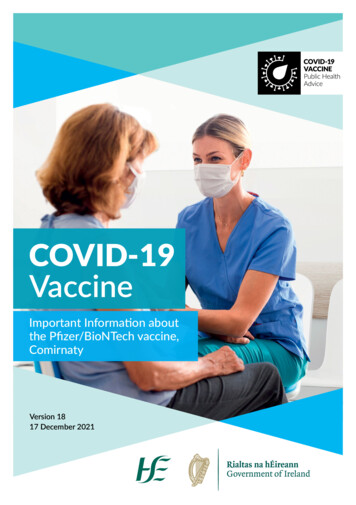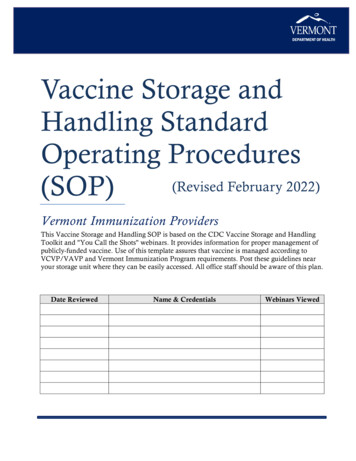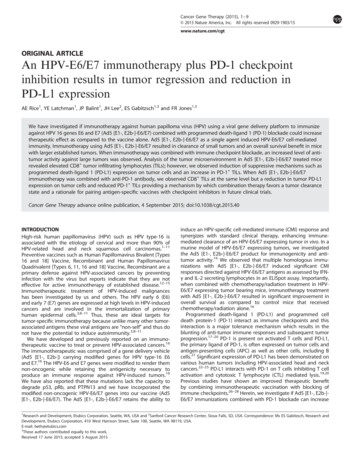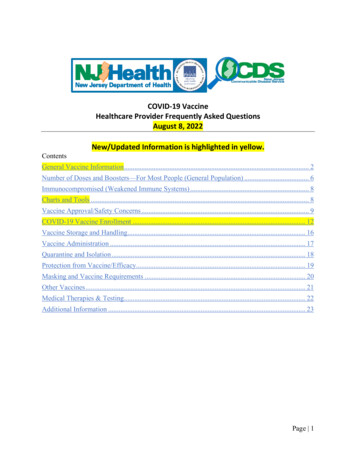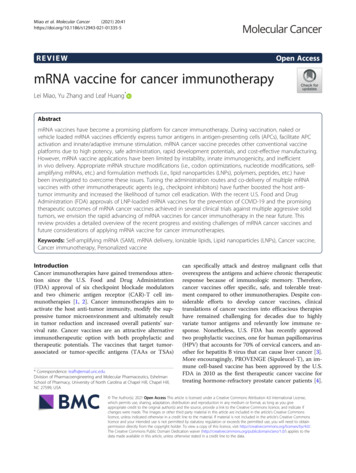
Transcription
Miao et al. Molecular Cancer(2021) IEWOpen AccessmRNA vaccine for cancer immunotherapyLei Miao, Yu Zhang and Leaf Huang*AbstractmRNA vaccines have become a promising platform for cancer immunotherapy. During vaccination, naked orvehicle loaded mRNA vaccines efficiently express tumor antigens in antigen-presenting cells (APCs), facilitate APCactivation and innate/adaptive immune stimulation. mRNA cancer vaccine precedes other conventional vaccineplatforms due to high potency, safe administration, rapid development potentials, and cost-effective manufacturing.However, mRNA vaccine applications have been limited by instability, innate immunogenicity, and inefficientin vivo delivery. Appropriate mRNA structure modifications (i.e., codon optimizations, nucleotide modifications, selfamplifying mRNAs, etc.) and formulation methods (i.e., lipid nanoparticles (LNPs), polymers, peptides, etc.) havebeen investigated to overcome these issues. Tuning the administration routes and co-delivery of multiple mRNAvaccines with other immunotherapeutic agents (e.g., checkpoint inhibitors) have further boosted the host antitumor immunity and increased the likelihood of tumor cell eradication. With the recent U.S. Food and DrugAdministration (FDA) approvals of LNP-loaded mRNA vaccines for the prevention of COVID-19 and the promisingtherapeutic outcomes of mRNA cancer vaccines achieved in several clinical trials against multiple aggressive solidtumors, we envision the rapid advancing of mRNA vaccines for cancer immunotherapy in the near future. Thisreview provides a detailed overview of the recent progress and existing challenges of mRNA cancer vaccines andfuture considerations of applying mRNA vaccine for cancer immunotherapies.Keywords: Self-amplifying mRNA (SAM), mRNA delivery, Ionizable lipids, Lipid nanoparticles (LNPs), Cancer vaccine,Cancer immunotherapy, Personalized vaccineIntroductionCancer immunotherapies have gained tremendous attention since the U.S. Food and Drug Administration(FDA) approval of six checkpoint blockade modulatorsand two chimeric antigen receptor (CAR)-T cell immunotherapies [1, 2]. Cancer immunotherapies aim toactivate the host anti-tumor immunity, modify the suppressive tumor microenvironment and ultimately resultin tumor reduction and increased overall patients’ survival rate. Cancer vaccines are an attractive alternativeimmunotherapeutic option with both prophylactic andtherapeutic potentials. The vaccines that target tumorassociated or tumor-specific antigens (TAAs or TSAs)* Correspondence: leafh@email.unc.eduDivision of Pharmacoengineering and Molecular Pharmaceutics, EshelmanSchool of Pharmacy, University of North Carolina at Chapel Hill, Chapel Hill,NC 27599, USAcan specifically attack and destroy malignant cells thatoverexpress the antigens and achieve chronic therapeuticresponse because of immunologic memory. Therefore,cancer vaccines offer specific, safe, and tolerable treatment compared to other immunotherapies. Despite considerable efforts to develop cancer vaccines, clinicaltranslations of cancer vaccines into efficacious therapieshave remained challenging for decades due to highlyvariate tumor antigens and relevantly low immune response. Nonetheless, U.S. FDA has recently approvedtwo prophylactic vaccines, one for human papillomavirus(HPV) that accounts for 70% of cervical cancers, and another for hepatitis B virus that can cause liver cancer [3].More encouragingly, PROVENGE (Sipuleucel-T), an immune cell-based vaccine has been approved by the U.S.FDA in 2010 as the first therapeutic cancer vaccine fortreating hormone-refractory prostate cancer patients [4]. The Author(s). 2021 Open Access This article is licensed under a Creative Commons Attribution 4.0 International License,which permits use, sharing, adaptation, distribution and reproduction in any medium or format, as long as you giveappropriate credit to the original author(s) and the source, provide a link to the Creative Commons licence, and indicate ifchanges were made. The images or other third party material in this article are included in the article's Creative Commonslicence, unless indicated otherwise in a credit line to the material. If material is not included in the article's Creative Commonslicence and your intended use is not permitted by statutory regulation or exceeds the permitted use, you will need to obtainpermission directly from the copyright holder. To view a copy of this licence, visit http://creativecommons.org/licenses/by/4.0/.The Creative Commons Public Domain Dedication waiver ) applies to thedata made available in this article, unless otherwise stated in a credit line to the data.
Miao et al. Molecular Cancer(2021) 20:41Besides these initial successful attempts in cancer vaccines, multiple personalized cancer vaccines combinedwith checkpoint blockage modulators or cytokine therapies are currently being evaluated in clinical trials, withsome promising clinical responses in multiple solid ormetastatic tumors [5, 6].There are four types of cancer vaccines, includingtumor or immune cell-based vaccines, peptide-basedvaccines, viral vector-based vaccines, and nucleic acidbased vaccines [7]. Nucleic acid (DNA- or RNA-) basedvaccine is a promising vaccine platform for multiple reasons. Firstly, nucleic acid vaccines allow simultaneousdelivery of multiple antigens covering various TAAs orsomatic tumor mutations, eliciting both humoral andcell-mediated immune response, increasing the likelihood of overcoming vaccine resistance. Secondly, unlikepeptide vaccines, nucleic acid vaccines can encode fulllength tumor antigens, allowing APCs to simultaneouslypresent or cross-present multiple epitopes with bothclass I and II patient-specific human leukocyte antigen(HLA), thus are less restricted by the human HLA typesand more likely to stimulate a broader T cell response[8]. Ultimately, nucleic acid vaccines are non-infectious,free of protein or virus-derived contaminations duringproduction, and are thus considered well tolerated forboth prophylactic and therapeutic applications [7]. Messenger RNA (mRNA) vaccine has recently emerged asan appealing alternative to DNA vaccine for infectiousdisease preventions and anti-cancer treatments. Advantages of mRNA over DNA as cancer vaccine strategy include: (1) mRNAs can be translated in both dividing andnon-dividing cells, where RNA only needs to be internalized into the cytoplasm, followed by a one-step translation into the antigen(s) of interest. The rate andmagnitude of protein expression of mRNA are typicallyhigher than DNA vaccines. (2) Unlike DNA vaccines,mRNA vaccines cannot integrate into the genome sequence, thus free of insertional mutagenesis. The firstreport of the successful expression of in vitro transcription (IVT) mRNA in mouse skeletal muscle cellsthrough direct injection into animals was published in1990, underlining the feasibility of mRNA vaccine development [9]. However, this early attempt didn’t lead tosubstantial mRNA vaccine development investigations,largely stemmed from concerns regarding mRNA instability, insufficient in vivo delivery, and high intrinsicinnate immunogenicity [10].Over the past decades, major technological innovations have enabled mRNA as a more feasible vaccinecandidate. Various modifications of mRNA backboneand untranslated regions make mRNA less RNasesensitive, more stable, and highly translatable. Improvedpurification methods have allowed mRNA products freeof double-stranded contaminations, thus reducing thePage 2 of 23non-specific activation of innate immunity. More efficient in vivo delivery of mRNA has been achieved byformulating mRNA into delivery vehicles, including butnot limited to lipid nanoparticles (LNPs), polymers, andpeptides. Lastly, IVT methods (free from isolation andpurification of biological samples) have been widely applied to the production of mRNAs. With the maturationof scale-up manufacturing, mRNA vaccines have supreme advantages over other vaccine techniques due tothe rapid, inexpensive production and large-scale deployment [11]. So far, non-replicating mRNAs aremostly investigated in clinical trials for cancer treatment.However, self-amplifying mRNAs (SAM) have gained extensive attention and are being evaluated in both cancerand infectious disease due to long-lasting efficacy andlower required dosages [12, 13].Up to now, over twenty mRNA-based immunotherapies have entered clinical trials with some promisingoutcomes in solid tumor treatments. Besides anti-cancerimmunotherapies, mRNA vaccines have a vast advantageto respond rapidly to the global explosion of the coronavirus disease 2019 (COVID-19). With the recent U.S.FDA’s approval of two mRNA-based vaccines fromPfizer-BioNTech and Moderna for emergency use inCOVID-19 prevention, the mRNA vaccine field will encompass a dramatic rise in the market value and will attract widespread interest in both cancer and infectiousdisease applications [14, 15]. In this review, we discussthe improvements that have been made on mRNA structures to increase stabilities and translation efficiencies,highlight the advantages and limitations of variousin vivo delivery vehicles for mRNA therapeutics, evaluatethe applications of SAM in cancer vaccines, andsummarize the current clinical applications of mRNAcancer vaccines. The data suggest mRNA vaccines havethe potential to overcome several challenges for cancerimmunotherapies.Basic mRNA pharmacology, limitations andadvantagesmRNA is a single-stranded macromolecule that corresponds to the genetic sequence of a DNA in the cell nuclei and is read by a ribosome and translated intoproteins in the cytoplasm [16]. The rationale behindmRNA as an appealing cancer vaccination platform is todeliver the transcript of interest(s), encoding one ormore TAAs or TSAs, into the host cell (typically APCs)cytoplasm, to be expressed into the targeted antigen(s).The expressed TAAs and TSAs can be presented to thesurface of APCs by major histocompatibility complexes(MHCs) to activate anti-tumor immunity. mRNA vaccine could induce both antibody/B cell mediatedhumoral responses and CD4 T/ CD8 cytotoxic T cellresponses, which are beneficial for efficient clearance of
Miao et al. Molecular Cancer(2021) 20:41malignant cells. On the other side, mRNA is non-infectiousand non-integrating, and therefore it’s quite tolerable andhas posed no genetic risks. There are mainly three types ofRNAs currently investigated as cancer vaccines: nonreplicating unmodified mRNA, modified mRNA and virusderived SAM. IVT has been commonly used for synthesizingboth non-replicating mRNA (modified and unmodified) andSAMs. The method utilizes a bacteriophage RNA polymerase, such as T3, T7 or SP6 RNA polymerase and a linearizedDNA template containing the target antigen sequences. TheIVT production precludes the usage of cells and their associated regulatory hurdles, and therefore the production ofmRNA is undoubtedly simpler, quicker and cleaner thanlarge-scale protein production and purification. The fundamental structure of conventional non-replicating IVTmRNA, which correspondent to “mature” eukaryotic mRNA,is composed of an open reading frame (ORF) region that encodes the target antigen sequences, flanked by five-prime(5′) and three-prime (3′) untranslated region (UTR), and further stabilized by 7-methylgaunosine (m7G) 5′ cap and 3′poly (A) tails respectively. The 5′ cap and 3′ poly (A) can beadded during the IVT or added enzymatically after initialIVT. In contrast, SAM comprises two ORFs, including onethat encodes the targeted antigen sequences and another thatencodes viral replication machinery which enables longlasting RNA amplification intracellularly. Once mRNA orSAM is internalized and transited to the cytosol, it will beread by ribosomes, and translated into proteins that undergoes post-translational modifications, ultimately resulting ina properly folded functional protein. The remaining IVTmRNA template will be degraded by normal physiologicalprocess, decreasing the metabolite toxicity risk [11].There are several limitations for initial applications ofmRNA in vaccine development. First, naked mRNA isquickly degraded by extracellular RNases, and is not internalized by APCs efficiently. Secondly, mRNA has intrinsic immunogenicity, which can activate downstreaminterferon related pathway to elicit innate immunity. Although this intrinsic immunogenicity can be functionedas adjuvant-like effect to boost immune response, however, it paradoxically facilitates mRNA degradation, reducing antigen expression. Moreover, the impurities,mainly double stranded RNA (dsRNA) generated duringIVT process, will potentiate the activation of innate immunity, further limiting mRNA translation. In the following sections, we will discuss these limitations andstrategies to overcome these limitations.Immunogenicity of mRNA and paradoxical effectsin Cancer immunotherapyInnate immune response is usually activated by host immune system through detecting exogeneous motifscalled pathogen-associated molecular patterns (PAMPs)via the pattern recognition receptors (PRRs) [17]. ThesePage 3 of 23receptors are particularly highly expressed in APCs, themajor target cell population of mRNA cancer vaccines.Exogeneous IVT mRNA is intrinsically immunostimulatory, as it is recognized by a variety of cell surface, endosome and cytosolic PRRs [11]. Recognition of IVTmRNA inside the endosome is mainly mediated by tolllike receptor (TLR)-7 and 8 (one type of PRRs), subsequently activates the myeloid differentiation marker 88(MyD88) pathway, leading to activation of Type-1 interferon (IFN) pathways and secretion of proinflammatorycytokines [17, 18]. In the cytosol, these exogeneousmRNAs are sensed by other PRR families, including retinoic acid-inducible gene-I-like (RIG-I-like) receptors,oligoadenylate synthetase (OAS) receptors, and RNAdependent protein kinase (PKR). These PRRs can sensedifferent RNAs, including dsRNA and single strandedRNA (ssRNA), blocking mRNA translation as reviewedelsewhere [17].The activation of multiple PRRs and production oftype I IFN can be paradoxically beneficial or detrimentalfor anti-cancer immunotherapy. It is potentially beneficial for vaccination since, in some cases, activation oftype I IFN pathways drives APC activation and maturation, promotes antigen presentation, and elicits robustadaptive immune responses. However, innate immunesensing of RNAs may be associated with inhibition ofantigen expression, and thus dampen immune response.Specifically, phage RNA polymerases produce unwanteddsRNA during IVT that can activate innate immunityvia PKR, OAS, TLR-3, MDA-5 (one type of RIG-I likereceptors). Once the PKR is activated, the eukaryotic initiation factor (eIF)-2 can be phosphorylated, blockingmRNA translation [17]. Moreover, the dsRNA activatesRNase L upon binding to OAS [19], causing degradationof the exogenous RNAs. Ultimately, binding of dsRNAwith MDA-5 and TLR-3 can activate Type I IFN, eliciting several other genes that inhibit the translation ofmRNA [20]. Besides the dsRNA impurities, improperlydesigned mRNA structure may also activate PRRs likeMDA-5 and PKR, abolishing antigen expression.The paradoxical impact of Type I IFNs activation isnot only restricted to antigen expression, but also shownon CD 8 T cell activation. The dual effect of Type IIFNs on CD8 T cell immunity have been extensivelyreviewed elsewhere [21]. In brief, the stimulatory or inhibitory actions of type I IFNs on CD 8 T cell activationis likely to be dependent on the timing and kinetics between activation of IFNAR signaling and TCR signaling,which may be further impacted by the routes of administration of mRNA cancer vaccines. For instance, severalstudies have shown that type I IFNs can potentially promote CD8 T cell response to systemic mRNA vaccination [18, 22]. One hypothesis is that, intravenous (i.v.)delivery of mRNA (typically delivered by cationic
Miao et al. Molecular Cancer(2021) 20:41lipoplex) is expressed in splenic DCs [18, 22], whereantigen expression and presentation take place simultaneously, with TCR signaling preceding or coinciding withIFNAR signaling. In contrast, type I IFNs can potentiallyinterfere with topical (i.d. or s.c.) mRNA vaccinationwhere antigen expression happens locally in the injectionsite, but antigen presentation takes place in the secondary lymphoid organs, with IFNAR signaling precedesTCR signaling [23, 24]. However, this IFNAR/TCR signaling theory is still debating, since other researchgroups have observed the opposite effects from local administration of mRNA vaccines [25, 26]. Therefore, thepurity of mRNA products, the modification of mRNAsequence, the design of delivery system and administration routes need to be tuned to properly active the innate immunity to initiate the adaptive immune response,simultaneously, averting the toxic overactivations thatinhibit antigen protein expression and immuneresponse.Strategies to improve mRNA translation efficiencyand overcome the innate immunogenicityFive-prime cap (5’Cap) modificationIVT mRNAs, which mimic the eukaryotic mRNA, usually have a N7-methylated guanosine added to the first5′ nucleotide through a 5′, 5′-triphosphate bridge for efficient translation in the eukaryotic system. This 5′ m7Gcap or m7Gppp- is typically referred to as “Cap 0”. The5′ cap recruits the eukaryotic translation initiation factor4E (eIF4E) to facilitate ribosome recognition and translation initiation. Both enzymatic and chemical strategiesare applied for mRNA 5′ capping. The most widely usedin vitro post-translational capping enzymatic method isthe Vaccinia capping system, which is based on the Vaccinia virus Capping Enzyme (VCE) [27]. The VCE consists of 2 subunits (D1 and D12). The D1 subunitpossesses triphosphatase, guanylyltransferase, and methyltransferase activity, all of which are essential for addinga complete Cap 0 structure, while D12 plays a valid rolein activating D1 [28]. Vaccinia capping system providesa near 100% capping efficiency with proper orientation,but efficient expression and purification for VCE are required for large scale capped RNA production [29]. Besides the enzymatic post-translational capping methods,chemical capping methods add cap analogs cotranscriptionally. However, regular cap analog addedduring IVT (co-transcriptional process) can be reverselyincorporated into the mRNA sequence. Therefore, approximately one third of mRNA molecules are not properly methylated, with free phosphate hanging at the 5′location, leading to low efficiency of downstream mRNAtranslation. To prevent reverse incorporation, antireverse cap analogs (ARCA) have been developed. ARCAis methylated at the C3 position (closer to m7G) toPage 4 of 23ensure the addition of a nucleotide only at the nonmethylated guanosine during IVT. ARCA capped mRNAincreases and prolongs protein expression in vitro. Toinhibit de-capping of the corresponding mRNA and increase binding affinity to eIF4E, ARCA have been furthermodified within the triphosphate linkage, either througha bridging oxygen (e.g. (methylenebis) phosphonate andimidodiphosphate) or a non-bridging oxygen (e.g. phosphorothioate and phosphorselenoate) [30, 31].Remaining limitations of ARCA caps are: (1) Relativelylow capping efficiency (60–80%); (2) Cap-0 structure isformed after capping; (3) Cap contains an unnaturalO’methyl group in the C3 position that can be recognized as exogeneous motif; (4) mRNA transcript muststart with guanine (G). 5’cap can be added enzymaticallyafter IVT to achieve 100% capping efficiency with a natural unmodified cap structure. However, the process iscostly and suffers from batch to batch variability. A nextgeneration co-transcriptional cap analog, CleanCap ,was developed in 2018 to overcome the issues associatedwith ARCA [32]. CleanCap utilized an initiating cappedtrimer to yield a natural unmodified cap structure withincreased capping efficiency to nearly 90–99%.Uncapped (5’ppp or 5’pp) or abnormally capped (Cap0) mRNAs can be recognized by PRRs [33], such RIG-1and IFIT, triggering type I IFN, blocking mRNA translation [20, 34, 35]. Therefore, a natural Cap-1 structure ispreferred. Cap1 structure can be enzymatically added byguanylyl transferase and 2′-O-methyltransferases orthrough the co-transcriptional CleanCap technology.To further avoid recognition by the innate immune system, capped-IVT mRNAs should be treated with phosphatases to remove uncapped phosphate, preventingPRR-mediated sensing and destruction of mRNA translation [36].Optimization of Untranslated regions (UTRs)UTRs can impact mRNA degradation rate and translation efficiency through interacting with RNA bindingproteins. 5′ UTR sequence can be optimized to enhancethe stability of mRNA and accuracy of translation.Firstly, avoid the presence of start codon (AUG), andnon-canonical start codons (CUG) in the 5′ UTR, asthese codons may disturb the normal translation processof ORF. Secondly, avoid the presence of highly stablesecondary structures, which can prevent ribosome recruitment and codon recognition. Thirdly, shorter5’UTR may be introduced as previous studies haveshown that this type of 5’UTR is more conducive tomRNA translation process. Ultimately, bioinformaticstool can be used to predict mRNA translation efficiencyaccording to 5’UTR sequence. α-globin and β-globinfrom Xenopus laevis or humans contain translation andstability regulatory elements, and are commonly used as
Miao et al. Molecular Cancer(2021) 20:41the 3′ UTR of IVT mRNA [37]. To further improveRNA stability, AU- and GU-enriched sequences can beintroduced. Moreover, transcription efficiency might beimproved by adding 3’UTR sequence twice in tandem[38]. Overall, UTR performance is dependent on species,cell type, and cell state. One needs to understand thepharmacology in the targeted cells to allow better designof UTRs of the therapeutic mRNA vaccines [39].Codon optimization of open Reading frame (ORF)Optimization of G and cytosine (C) content in the ORFcan be applied to regulate the translation elongationrate. Uridine depletion is another codon optimizationstrategy that can directly be linked to an increased GCcontent. Uridine-rich regions can be recognized by RIGI, and its activation may lead to abolishing of protein expression. Moreover, the sequence can be optimized tohave the same ratio of every codons found naturally inhighly expressed proteins in the targeted cells or to usethe best pairs of codons that are commonly seen in thesehighly expressed proteins. In addition, codons withhigher tRNA abundance are usually used to replace rarecodons in ORF to increase the translation rate. Lastly,highly stable secondary structures and hairpin loopsshould be avoided in the ORF [17]. However, high translation rate is not all beneficial, as some proteins requirea low translation rate to correctly and effectively fold[31]. Therefore, codon optimizations in the ORF shouldbe carefully monitored to ensure moderate translationrate and high translation accuracy. Thess et al. demonstrated that sequence engineered but chemical unmodified mRNA is fully suited for use in mRNA therapies,and the protein expression level was even higher thanchemically modified but without codon optimizedmRNA, indicating the importance of codon optimizationin improving mRNA expression efficiency [40].Poly (a) tail modificationPoly(A) sequence can slow down the degradationprocess of RNA exonuclease, increase RNA stability, andenhance translation efficiency. A suitable length ofPoly(A) is crucial. Commonly used Poly(A) is 250 unitsin length, but different cells may have different preferences. For example, the optimal length of poly(A) in human monocyte-derived DCs are 120–150 nucleotides, inhuman primary T cells are 300 nucleotides [17]. Moreover, Poly (A) binding protein (PABP) can interact with5’cap through translational initiation factors, such aseIF4G and eIF4E, forming a close-loop to impact mRNAstructure [17, 41]. Recent study by Lima and coworkersfound that shorter poly(A) sequence could promote thisclosed-loop structure for efficient translation [41].Therefore, future studies should evaluate the role ofPage 5 of 23poly-A size in kinetic expression of IVT-mRNA antigen[17, 21].Nucleoside modified mRNAAnother method to improve mRNA stability, translationefficiency and mRNA vaccine potency is to modifymRNA transcripts with alternative nucleotides [42–45].Pseudouridine (Ψ), 1-methylpseudouridine (m1Ψ), and5-methylcytidine (m5C) are used to replace the naturaluridine and cytidine, and thus to remove intracellularsignaling triggers for PKR and RIG-I, leading to enhanced antigen expression. Kariko et al. have found thataltering nucleosides in the mRNA’s structure (e.g., 5mCor Ψ) can substantially reduce innate immune activationand increase translational capacity of mRNA [44, 46–48].Post-transcriptional epigenomic RNA modificationscan also be a powerful approach for improving mRNAtranslation and evading innate immune response. Arango and coworkers reported that post-transcriptionalRNA modification with N4-aceylcytidine (ac4C) enhanced mRNA translation in vitro and in vivo [49].Moreover, the function of post-translational epigenomicmodifications in DC activation has been demonstratedby mettl3, an RNA methyl transferase which mediatesmRNA m6A methylation and induces DC activation [17,50].Purification of IVT-mRNAAs mentioned in section 2, phage polymerase in IVT canyield multiple contaminants, including short RNAs generated from abortive initiation event and dsRNA produced by self-complementary 3′ extension [46]. TheseRNA contaminants can activate intracellular PPRs, including PKR, MDA-5, OAS etc. and lead to abolish ofmRNA translation and activation of innate immunity.Kariko and coworkers have demonstrated that the removal of these RNA contaminants result in mRNA thatdoes not induce IFNs and inflammatory cytokines, ultimately leading to10- to 1000-fold increase in proteinproduction in human primary DCs [46]. dsRNA speciescan be reduced during IVT by decreasing Mg2 concentration or by producing RNA at elevated temperature[17]. A more complete and scalable removal of dsRNAwas performed by high-pressure liquid chromatography(HPLC) [46, 51]. However, HPLC purification of mRNAis usually high cost and low yield ( 50%). Recently, afast and cheap purification method has been reported byBaiersdorfer et al. The method utilized the selectivebinding of dsRNA to a cellulose powder in ethanol containing buffer combined with fast protein liquid chromatography (FPLC) to remove up to 90% of dsRNA [52].Another way to completely get rid of dsRNA contaminants is through solid phase synthesis of mRNA rather
Miao et al. Molecular Cancer(2021) 20:41than IVT. For instance, Shivalingam et al. has synthesized RNA fragments up to 70 nucleotides using thesolid phase method. The RNA fragments were then ligated to become full length mRNA. This process is scalable and completely avoids the formation of dsRNA[53].Utilizing the impact of type I IFN for improved mRNAvaccinationAs mentioned earlier, type I IFN shows paradoxical impact on the immune response of mRNA cancer vaccine.Several studies have demonstrated that increased innateimmune stimulation driven by mRNA and delivery system modifications are not necessary for increased immunogenicity [23, 24, 54]. Other studies indicated thatenhanced immune responses via combination with alternative adjuvants are required for mRNA vaccines toachieve the targeted anti-tumor therapeutic outcomeand improved patients’ survival. Islam and coworkershave reported mRNA pulsed with a palmitic acidmodified TLR7/8 agonist R484 markedly improved theMHC class I presentation of OVA mRNA derived antigen in APCs, subsequently induced a more effectiveadaptive immune response in a tumor bearing mousemodel as compared to mRNA vaccine without the adjuvant [55]. Moreover, the RNActive vaccine platform developed by CureVac AG. used RNA/protamine complexas an adjuvant to activate TLR7/8, induce Th1 T cell response. Enhanced antitumor immunity was achievedwhen dosing RNA/protamine adjuvant with the naked,unmodified mRNA encoding antigens [5]. In addition tousing TLR agonists as adjuvants, stimulator of interferongenes (STING) agonists have been recently applied asimmunomodulators for combination with mRNA andpeptide vaccines [56, 57]. Miao et al. have shown thatloading of mRNA cancer vaccines into LNPs with intrinsic STING-IFN activation function produced a potentand prolonged CD8 T cells response [57]. Improved antitumor efficacies were observed in three cancer modelswith the addition of STING activating lipids. Recently, acombination of pro-inflammatory cytokines and chemokines have also been exploited to boost the antitumorimmunity of mRNA vaccines in both pre-clinical andclinical studies. In one clinical study, a DC-based mRNAvaccination composed of a mixture of TAAs were administrated together with DCs electroporated withmRNA encoding CD70, CD40 ligand (CD40L), and constitutively active TLR4 (TriMix). The combination therapy resulted in an encouraging rate of tumor responsesin patients with stage III or IV melanoma [58]. Costimulatory molecules CD70 and CD40L, together with activeTLR4, play crucial roles in the activation of DCs andpriming of CD8 T cell responses [59]. The cytokinecocktails are not only used to prime DC and T cellPage 6 of 23functions, but can also be dosed intratumorally to reshape the tumor microenvironments. For instance, intratumoral injection of mRNA-encoding cytokines IL-23,IL-36 , and T cell co-stimulatory OX40L can overcomethe suppressive tumor environment and produce effective systemic antitumor immunity [60]. Studies in combination of adjuvants with mRNA vaccines areblooming, but this strategy should be used with cautionas it could be counterproducti
mRNA in vaccine development. First, naked mRNA is quickly degraded by extracellular RNases, and is not in-ternalized by APCs efficiently. Secondly, mRNA has in-trinsic immunogenicity, which can activate downstream interferon related pathway to elicit innate immunity. Al-though this intrinsic immunogenicity can be functioned
